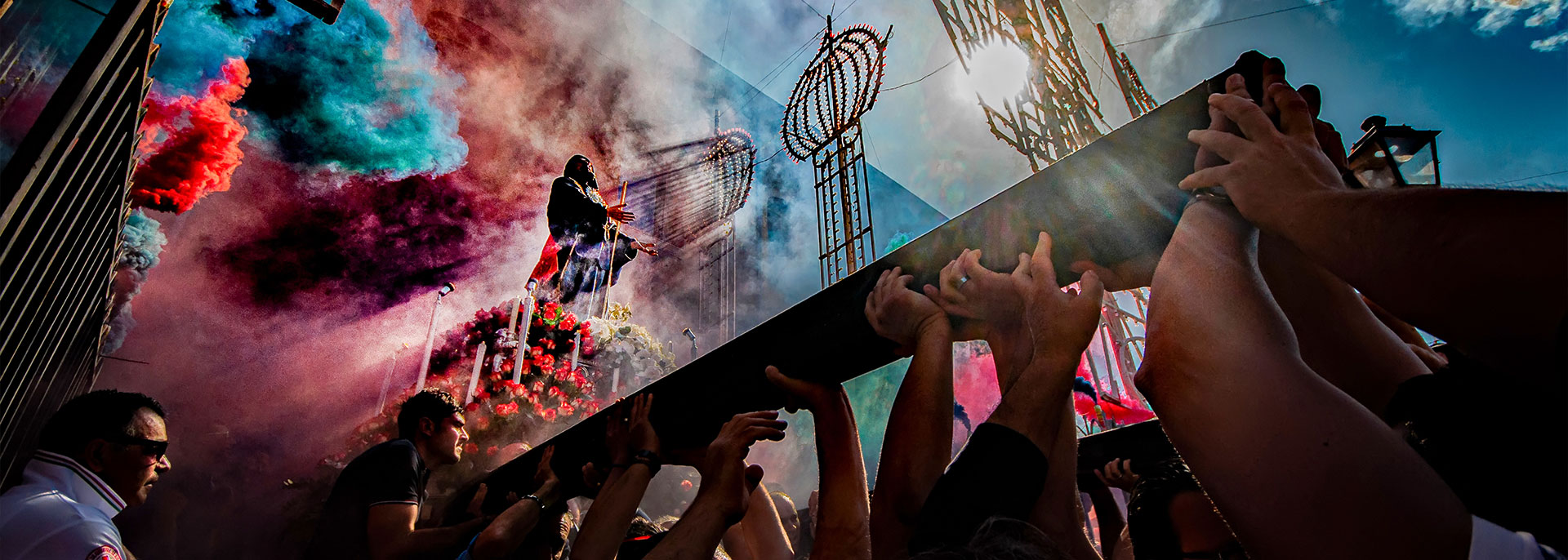The true soul, the most authentic soul of Milazzo and its people is manifested above qll in religious feasts multiform ecpressions of that ancient and variegated patrimony of island folklore that here, more than elsewhere is strongly sedimented in collective experience. These are feasts characterising the community, marked by strong ritual signs, able to communicate authentic sentiments of faith ans devotion, which still today are configued as privileged loci of memory and hence precious opportunities for recovery of collective identity.
A town celebration
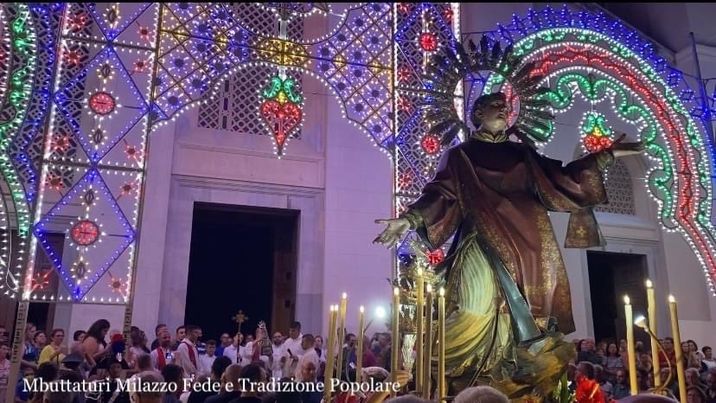
They are testimonies to remote epochs, to be safeguarded against the peril of a pressing threat of cultural standardisation and to hand down intact to future generations, since in them the very history of the town is inscribed. The festive universe of Milazzo is a sizeable one, jealously preserved with obstinate pride and doggedly evoked, as an opportunity not only for religious aggregation but also for socialisation, in addition to being as essential complement to the most modest economic activies. Mamertine popular devotion mostly goes to the patron saint, St. Stephen, whose feast is on the first Sunday in September, when there is a solemm and evocative procession that winds through the streets of the town, trasforming alleys and squares into an immense natural theatre in which people are at once protagonists and spectators.
The cortege starts from the Cathedral, following a very precise itinerary, the street of the procession, almost a stage that in the past allowed, and perhaps still allows, the various social components on one hand to pay homage to the saint and on the other to represent themselves annually on the town's stage. The blessing of the relic of the saint concludes the procession. Choral participation characterises the feast of the other patron saint, St. Francis of Paola. The rite is repeated every year on the first Sunday in May with a fascinating procession that attracts a multitude of devout people from all over the island. From the church dedicated to the saint, which is on the San Biagio hill, people carry the vara (bier) with the sacred image in it on their shoulders. The bearers vie for the privilege of supporting the weight of the simulacrum throught the town's streets and up the steep slope as far as the castle. They are followed by a swaying mass of faithful people. The procession goes on a full six hours and the route is longer than that of any other processional itinerary.
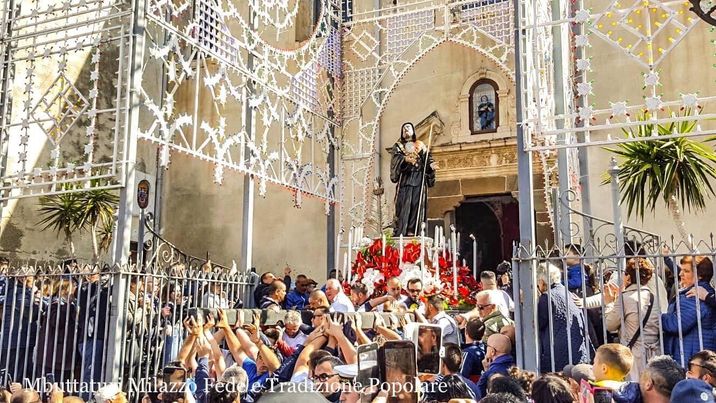
This is a way for the devout to show their attachment to St. Francis, thought of more as a man than as a saint, so much so as to imagine a direct and privileged rapport between the protected person needing help and the protector to be invoked for miraculus help in moments of existential precauriousness. When the simulacrum goes past the processiom gets thicker and thicker, reaching its acme at the harbour, near the sea where, saluted by the shrill sound of sirens aboard dozens and dozens of boats, the bier goes onto a ferry to commemorate the miraculous crossing of the Straits of Messina. Lastly the simulacrum goes back to the sanctuary in an atmosphere of great jubilation and fascination. The procession is an original and quaint festive ceremony that serves to sacralise places and extol deep popular faith. The tradition recounts that St. Francis arrived in Milazzo in 1464, and stayed there for some years. It is said that during his sojourn he performed many miracles.

One in particular is remembered by popolar devotion: the crossing on foot of the Straits of Messina, after a boatman refused to take him from one shore to the other. The feast proper is preceded by the rite of the "thirteen Fridays", which is said to have been instituted by St. Francis himself to commemorate the twelve Apostles and Crucified Christ. For thirteen consecutive Fridays the sanctuary of St. Francis is the destination of a moving pilgrimage by those who have to ask the saint for some act of benevolence. In the calendar the rite of the "berrettella" (little cap), the most heartfelt moment of the celebrations for St. Francis, is on the Tuesday after the feast; in it the sacred blends with the profane without clearly defined limits. It is a rite in the rite, linked to the old popular custom of trasferring to objects which belonged to a saint the thaumaturgic power attributed to saints themselves. Indeed, the "little cap" is nothing but the head-dress that St. Francis used to wear. The relic is carried in a procession throught the town, and to the harbour, and even taken on board a fishing boat; it is followed by a multicoloured cortege of boats in a fascinating procession on the sea.
A contribution is made to the general excitement by the multiple sounds characterising the procession, from the music of the bands to the joyful shouts of the people. After going round the Luigi Rizzo spit, all the boats stop in the splendid scenario of the Gulf of Milazzo, while a young man recites the sailor's prayer, and a laurel wreath, prepared by the tertiaries of St. Francis, is thrown into the water to commemorate those who have died at sea. Taken back onto the land, the relic goes back to the sanctuary in a solemn procession. The sea is the symbolic element that accompanies another feast which is very popular with the Milazzo community: that of the Madonna of the Rosary, on 13 October.
The bier is carried in a procession throgh the town as far as the harbour where, with the blessing of the sacred wood of the cross, the benevolence of the Madonna is invoked for the people of the sea. The procession continues as far as the Santa Maria Maggiore church, where another blessing will be imparted, to end at the Rosario church. Another feast is celebration of the Madonna of the Resurrection, pn the Easyer Monday, mainly held at the Carmine church. There is a close devotional link between the Madonna and the relevant confraternity, also known as the "Company f good death", instituted way back in the eventeenth century for the humanitarian purpose of offering help and assistance to people in prison, and to people who were suffering and dying. Precisely because of these gestures of human compassion,the Madonna to whom the brethren are devoted is known as the Madonna of Pity. Also of great interest is the feast of the Most Holy Crucifix, on the Tuesday after Easter.
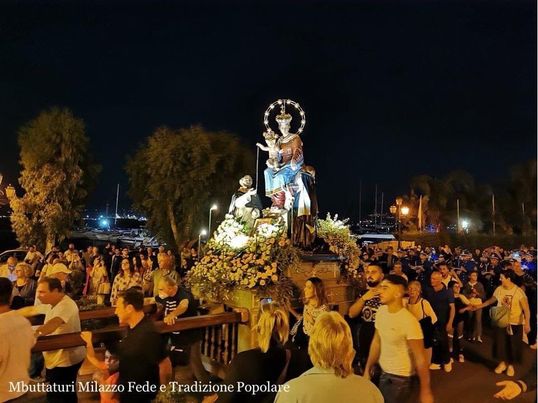

Linked to the San Papino community, the celebration is now limited to the parish, while in the past the sacred image of Christ on the cross, depicted in the beautiful masterpiece by Brother Umile from Petralia, was carried in a solemn procession all through the town. The rite, through a fascinating evocation, aims to commemorate the weeping of Crucified Christ that put an end to a long famine, a miracle reported by late eighteenth-century chroniclers. However, because of its universal values. Easter remains the feast richest in symbolic meanings, without any temporal limitation. A spectacular live representation of the Via Crucis enlives the old part of the town. More than a hundred actors, in period costumes, go in a pagent through the streets evoking the Passion of Christ. Piazza Roma becomes the theatre of the "arrival in Jeurasel", the Capuchin monastery that of the Immaculate Virgin, the sad place of the trial and condemnation.
The station of the Via Crucis mark out the rhythm of the weary climb up to the castle, where the rite ends with the Crucifixion and the Deposition. A touching nocturnal pilgrimage to Cape Milazzo, where there is the Sant'Antonio church, characterises the feastof the saint, on 13 June. Thousands of faithful people from all over Sicily converge in the original church entirely hewn out in the rock, to ask the saint for protection. According to the tradition, the grotto, which later became a place of cult, in 1221 gave shelter to St. Anthony, who was shipwrecked during the voyage that should have taken him back to his native Lisbon, whence he had set out a few years before as a missionary. After his death, the grotto became one of the most sacred places for Milazzo people, who in that sudden halt saw a particular benevolence of the saint towards their land.
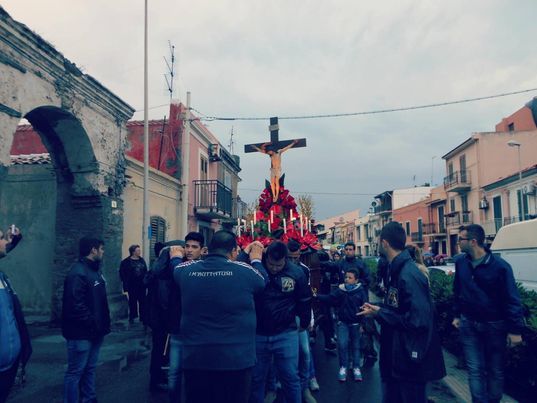
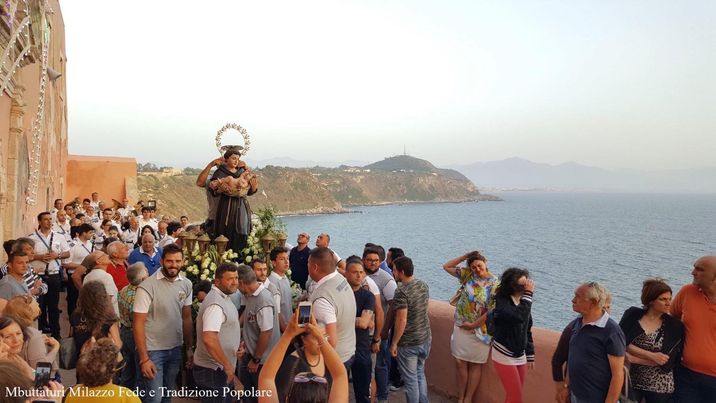
Many other minor feastes, which are just as popular, characterise the feast univerce of Milazzo, bearing witness to the great richness of local culture. There are rites that, though each having their own identity, are almost identical: the adoration of the simulacrum in the church, the procession reflecting the hierarchic structure of the community, the crowd of faithful, the presence of bands, the fireworks. On te second Sunday in September, in the Tono area, copying the example of nearby Tindari, local people celebrate the Black Madonna with a solemn procession. The tradition was introduced in the 1930's by the last descendants of the rais of the Tono tuna processing station, once one of the most important in Sicily. The distribution of the blessed "San Brasi" loaves is a custom typical of the feast of the St. Blaise, the protector of the throat. The offering of bread, because of the sacral nature of this food, is the central moment of the religious celebration held in every parish, on 3 February, involving the whole town. On the Sunday after Ester, hence a long time after the canonical celebrations, there is the feastof St. Joseph.
The procession with the bier starts from the San Giuseppe church and goes through the streets of the town, followed by a large crowd of faithful. On the Sunday after 16 July, the simulacrum of the Madonna del Carmelo is carried in a procession through the town. Instead, a curious custom is present in the feast of Santa Rita da Cascia, on 22 May. Many devout people dry blessed roses in churches, attributing healing powers to this flower, which was dear to the saint. On the eighth Sunday after Easter, at the church on Cape Milazzo, there is celebrated the feast of theMost Holy Trinity. Lastly, another choral moment is Corpus Christi, celebrated with a solemn procession in which children participate that have taken first communion.








